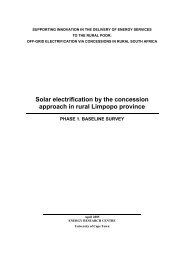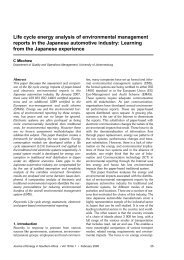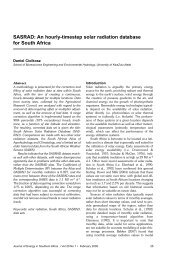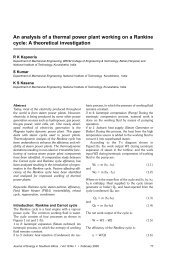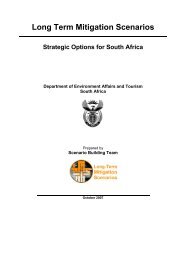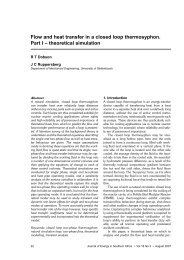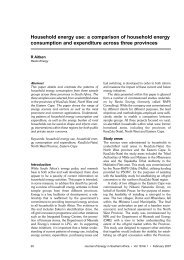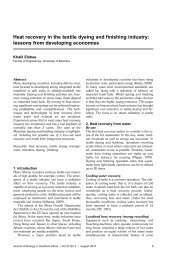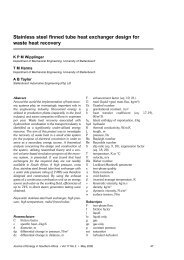Climate variability, climate change and water resource strategies for ...
Climate variability, climate change and water resource strategies for ...
Climate variability, climate change and water resource strategies for ...
You also want an ePaper? Increase the reach of your titles
YUMPU automatically turns print PDFs into web optimized ePapers that Google loves.
<strong>Climate</strong> <strong>variability</strong>, <strong>climate</strong> <strong>change</strong> <strong>and</strong> <strong>water</strong> <strong>resource</strong> <strong>strategies</strong> <strong>for</strong> small municipalities<br />
case of the Richtersveld Local Municipality, the only representative town is Lekkersing which has a<br />
largely interrupted data set. Calvinia, Leliefontein, Steinkopf, Lekkersing <strong>and</strong> Sutherl<strong>and</strong> all fall into<br />
the winter rainfall region while Pofadder, Van Wyksvlei <strong>and</strong> Kenhardt all receive predominantly<br />
summer rainfall.<br />
Namakwa<br />
Table 8: Representative towns <strong>for</strong> each local municipality<br />
District municipality Local municipality Representative town<br />
Hantam<br />
Kamiesberg<br />
Nama Khoi<br />
Richtersveld<br />
Karoo Hoogl<strong>and</strong><br />
Khâi-Ma<br />
Calvinia<br />
Leliefontein<br />
Steinkopf<br />
Lekkersing<br />
Sutherl<strong>and</strong><br />
Pofadder<br />
Karoo Kareeberg Van Wyksvlei<br />
Siy<strong>and</strong>a !Kai! Garib Kenhardt<br />
Precipitation displays a high degree of interannual <strong>variability</strong>, with single extreme events skewing<br />
simple analyses, <strong>and</strong> hence precipitation is difficult to analyse in terms of trends (Midgley et al.<br />
2005). This is demonstrated in the selection of graphs below where the linear regression does not<br />
have a very good correlation coefficient (R 2 ). (Although not presented here, the logarithmic<br />
regression does not yield better results). Whilst the trend lines may indicate an decrease in<br />
precipitation over the period <strong>for</strong> most cases, the extreme highs <strong>and</strong> lows greatly influence the<br />
determination of any true trend in the data.<br />
What is particularly evident from all the graphs however, is that rainfall is highly variable from year<br />
to year, with periods of more plentiful rainfall followed by periods of drought. This makes planning<br />
<strong>for</strong> times of drought difficult yet essential, since with large interannual variabilities there are no<br />
rainfall guarantees in any year.<br />
The recorded summer <strong>and</strong> winter rainfall records <strong>for</strong> each of the eight towns <strong>for</strong> the past 30 years<br />
can be found in Appendix A. All the towns exhibit <strong>variability</strong> in rainfall.<br />
Calvinia Rainfall - Winter<br />
Rainfall mm/month<br />
60<br />
50<br />
40<br />
30<br />
20<br />
10<br />
0<br />
R 2 = 0.05385<br />
1971<br />
1972<br />
1973<br />
1974<br />
1975<br />
1976<br />
1977<br />
1978<br />
1979<br />
1980<br />
1981<br />
1982<br />
1983<br />
1984<br />
1985<br />
1986<br />
1987<br />
1988<br />
1989<br />
1990<br />
1991<br />
1992<br />
1993<br />
1994<br />
1995<br />
1996<br />
1997<br />
1998<br />
1999<br />
2000<br />
2001<br />
2002<br />
2003<br />
2004<br />
year<br />
Figure 7: Winter rainfall trends <strong>for</strong> Calvinia between 1971 <strong>and</strong> 2004<br />
14




